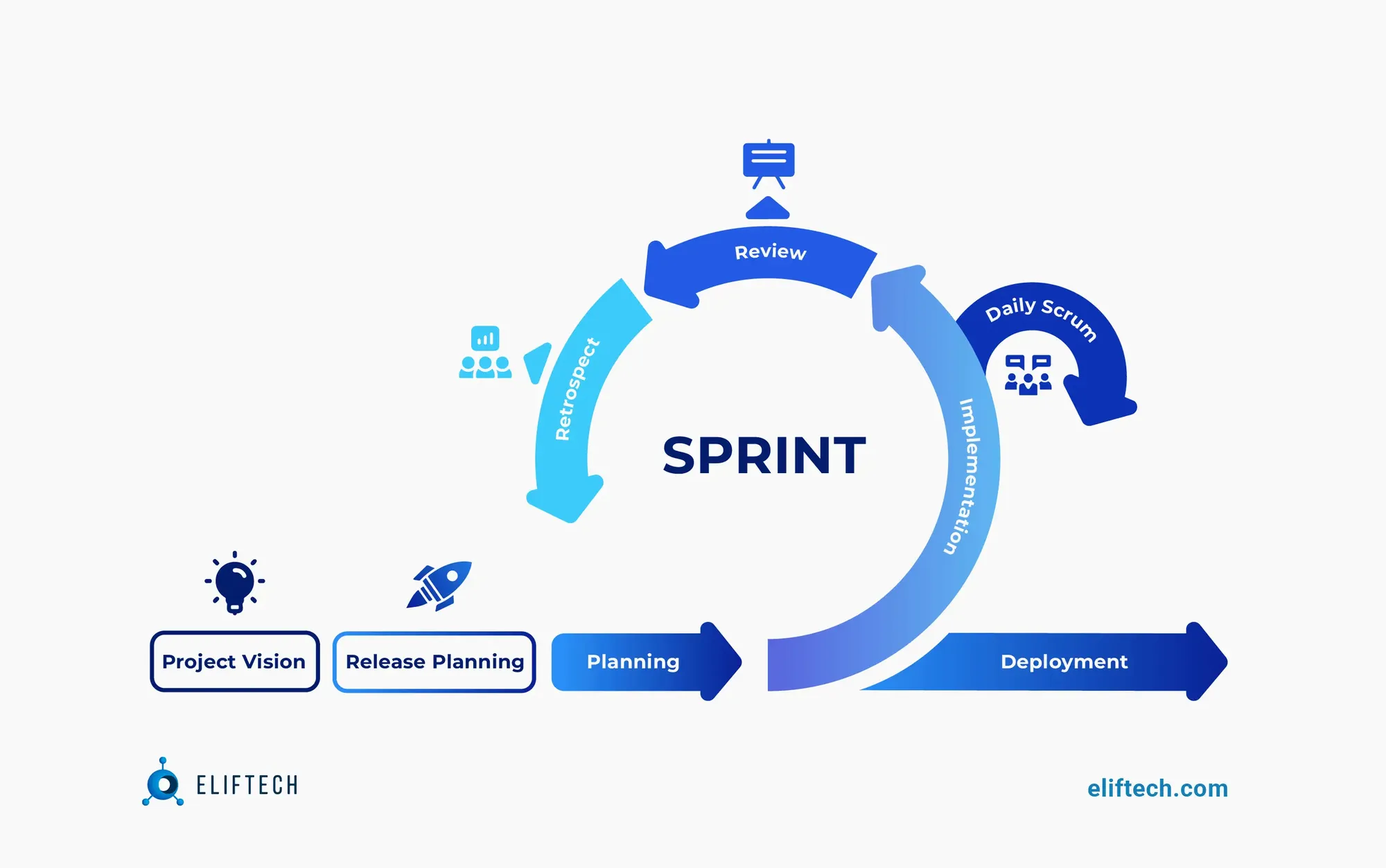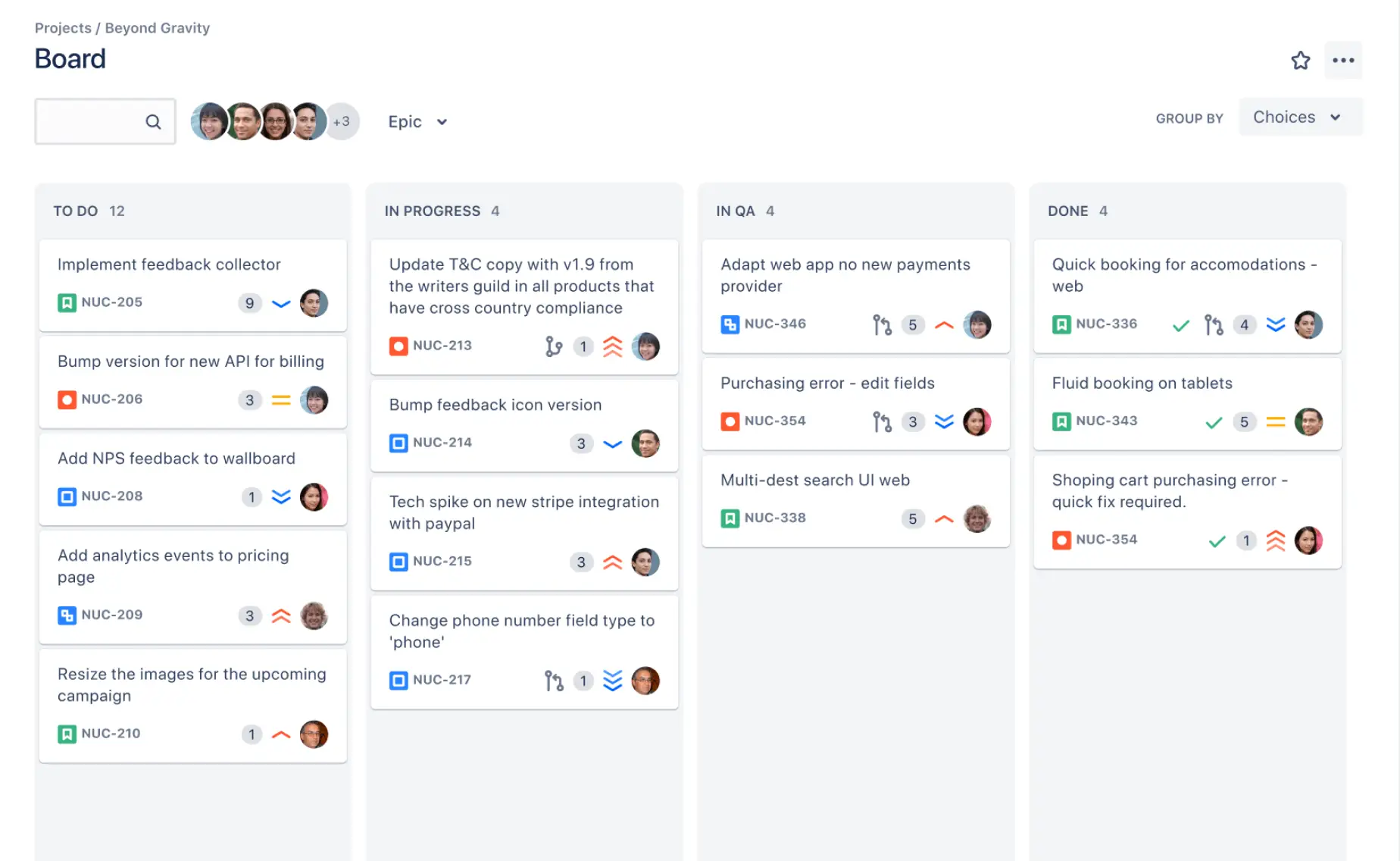Outsourcing
How Project Management for Application Development Works

Reputable development companies always strive to innovate, grow, and provide value to their clients. The only possible way to achieve these goals is to set up the correct project management for application development from the start by following a well-structured project management flow.
While companies may have different project management approaches in outsourcing IT projects, they all have the same goal: delivering great results and maximizing product value. However, to come up with an ideal project workflow, most development companies often go through fire and water.
ElifTech has ten years of experience delivering projects, and we've encountered many challenges during that time. These challenges have been valuable lessons that have shaped our approach to project management, giving us the expertise to define our best practices for outsourcing and deliver high-quality solutions no matter what. So, we're excited to share all our insights, knowledge, and experience in the following sections.
How to Manage a Software Development Project?
Project management for application development is largely guided by the principles outlined in the Project Management Body of Knowledge (PMBoK). While we won't delve into the specifics of PMBoK, we use this methodology to provide a structured approach to each phase of our project management process. As a software development company, we place a high value on agility. To stay swift and responsive, we integrate the Agile Manifesto – a set of underlying values for Agile Software Development, into our operational workflow. This includes employing the Agile Triangle's principles, focusing on value, quality, and constraints, derived from the Classic Project Management Triangle, instead of merely scope, cost, and schedule.
Additionally, we offer consultation services to augment our software development project management. We partner with our clients to maximize their product's value by assisting in tasks that drive their desired outcomes. Our range of consulting services includes:
- Project discovery.
- Developing a product vision.
- Defining, evaluating, and prioritizing tasks, along with scheduling the scope.
- Preparing comprehensive roadmaps and reasonable version limitations.
These activities help our partners achieve optimal results and remain competitive in their respective markets.
Project Initiation and Planning
Project initiation means we're at the starting line, and this phase is all about setting the stage for a successful project. As an IT outsourcing company, most of our projects begin when our clients reach us with an idea or a problem they need to address. However, during the initiation phase, our team has to accomplish several tasks:
- Establishing the customer's key values and project goals. We define the project's boundaries - decide what the project will include and what it won't.
- Identifying success parameters for our own reference. We figure out what results we expect from the project. This helps us track successful progress through the project.
- Anticipating potential queries to minimize uncertainties. We create a business case for why the project is worth doing, explaining why it matters and what benefits it can bring.
- Documenting all client needs and anticipations. We come up with a clear document that specifies what the project aims to do, what's in and out of scope, and what it will deliver. Our development team uses this document as a reference when implementing the project.
Before transitioning to planning, we need answers to crucial questions—Is the client influenced by scope, deadline, or budget? What are the future aspirations for project advancement? Are there any specific regulations to abide by for the project?
These queries represent a fraction of the bulk because outsourcing IT projects are unique and demand a specific approach. Nevertheless, the responses provide us with preliminary cost estimates for potential development.
Following these preliminaries, the planning phase is ushered in—we typically kickstart with the discovery phase. During this step, we set tech requirements, determine the right tech stack, build wireframes, and approve them with clients.
Another essential aspect is to prioritize the requirements to discern our starting point—our regular practice revolves around beginning with the most critical (core features) or the most unpredictable features (high-risk areas). Addressing these "grey areas" urgently helps us provide customers with more reasonable development time and cost approximations.
If the client's focus is deadline-oriented, we contemplate the features achievable within the specified timeframe and devise a development roadmap (project readiness level at given deadlines).
For this, we need to evaluate the available team capacity and settle the team composition— number of available developers, additional team members required (QA, Tech Lead, and others), etc. This, in turn, enables us to furnish the client with a far more precise development cost estimate.
As one of the best practices for outsourcing, we consolidate all our planning efforts into a Software Requirements Specification (SRS). This document acts as our project's blueprint, detailing what the product should do and how it will be built. It keeps everyone on the same page and serves as a reference point throughout the project, ensuring we stay on track and achieve our goals.
Software Development Project Management: Team Roles and Responsibilities
Software project development is a collaborative process that requires a diverse team of professionals each with specific roles and responsibilities. Here's a breakdown of these roles:
1. Project Manager (PM)
The PM oversees and coordinates outsourcing it projects. Their primary responsibilities involve:
- Planning, scheduling, setting project goals, and defining a project's scope.
- Coordination and communication between team members and stakeholders.
- Ensuring that the project remains on schedule and within the defined budget.
2. Product Owner (PO)
In agile development, the PO represents the business or user community and the team's voice. They are responsible for:
- Defining and prioritizing the product backlog.
- Accepting or rejecting work results.
- Collaboration with both stakeholders and the team to ensure the produced work aligns with business needs.
3. Software Developer/Engineer
Software developers are the backbone of the team, working on the actual development of the software. Their responsibilities include:
- Writing clean, efficient, and testable code.
- Identifying and fixing software defects.
- Participating in code reviews.
4. Quality Assurance (QA) Engineer
QA engineers ensure that product quality meets agreed standards before it's released to the end-user. Their main responsibilities include:
- Creating a testing strategy and executing it.
- Identifying and documenting software defects.
- Ensuring software functionality conforms to the requirements.
5. UX/UI Designer
UX/UI designers focus on the product's look-and-feel and usability aspect. Their tasks include:
- Creating intuitive and user-friendly interfaces.
- Developing and maintaining design wireframes and specifications.
- Testing designs for usability and accessibility.
6. System Architect
A system architect designs the software architecture accommodating business requirements. Responsibilities include:
- Designing the software and network infrastructure.
- Responsible for the software's technical standards and choices.
- Ensuring the system's long-term scalability and performance.
During project management of software development, each role in a team is crucial for the project's successful completion. Understanding these responsibilities can help in generating a more effective and efficient team.
Project Execution
Our approach leans heavily on Agile IT project management methodologies such as the Scrum framework during the development stage. Expounding this approach means segmenting the development process into distinct components. A structure incorporating events like sprint, sprint planning, daily standups, demos, and retrospectives is an optimal fit for us. We will delve into every aspect of the development stage now.
Sprint: The cornerstone of Scrum, the 'sprint', is a designated time period (typically 2-4 weeks, with us favoring a 2-week duration) during which predefined tasks and activities are completed.
Sprint Planning: This occurs on the first Monday of the sprint. During this process, we determine the workload for the ensuing 2 weeks, refresh the roadmap, apportion tasks among developers, specify code freeze deadlines (the stage when modifying the code escalates in complexity due to its development level), and discuss prospective Quality Assurance endeavors.
The key outcomes of sprint planning include a structured timeline, revised capacity projections (to factor in changes about vacations or sick leaves), clarity over the user value that this sprint embodies, and the stamp of approval from other stakeholders on the sprint structure.
Daily Standups: These sessions revolve around three questions: What was accomplished yesterday? What is the action plan for today? What impediments are being faced? Ideally, these meetings are concise (under 20 minutes) and surface-level, avoiding deep dives into specifics. The objectives are to glean updates on development progress, synchronize team efforts, and resolve minor glitches. Regular client updates are paramount to prevent misunderstandings and false anticipations.
Demo: Scheduled for the concluding Friday of the sprint, the demo is an opportunity to showcase the product's current state to the client while soliciting feedback on newly minted features. It is our practice to thoroughly vet everything before presenting it to our clients. If further modifications are requested by the client, we assess the impact it will have on the budget before adjusting the product in line with feedback, always securing written confirmation for any alterations.
Retrospective: Serving as the concluding event of Scrum, this is when team members explore the positive and negative experiences during the sprint. It's similar to conducting a post-project analysis, identifying strengths and areas for enhancement. The ultimate goal is to draw up a list of areas for improvement in the upcoming sprint.

Monitoring and Controlling
Monitoring and controlling is the stage where we keep an eye on the project's progress. We regularly check how well the project is doing compared to the plan, making sure we meet our goals, stay on schedule, and stick to the budget. Our controlling approach rests on four central pillars – time control, task control, capacity control, and quality control. We'll explore each one in depth.
Time control
In the context of software project development, time control equals budget control. Every client has a specific budget and certain expectations, so it's crucial to have a good system for managing time and regularly reporting on how time is being used. We have two forms of time management:
- Sprint-specific reports on hours expended and shared with clients after each sprint.
- Cumulative report on hours expended on explicit tasks from the backlog.
The first report is compiled by tracking team hours. Besides the hours spent, the report includes sprint time and user stories (hypothetical scenarios capturing user needs). An example of a user story could be, “As a first-time user, I want to sign up using Facebook,” detailing the required feature – Facebook Login.
To produce the second report, we lean on the first, using it as a foundation. The aim is to compare the total hours consumed on each user story and juxtapose them with the maximum estimates. If the budget risk of overstepping arises, we promptly inform the client for further authorization. If denied, we strive to find mutually satisfactory alternatives.
Task control
Task Control, as suggested by its name, revolves around tracking and managing all the tasks that are to be tackled within each sprint. For efficient task handling, we resort to the Kanban board, which classifies tasks into different stages - To Do, In Progress, In Review, Merged, Ready for Quality Assurance, and Completed.
- To Do: A feature gets listed as a user story at this stage. We then proceed to estimate the potential development cost and seek approval from the client. After receiving approval, the task is included in the assigned sprint, and a developer is identified to take charge.
- In Progress: During this phase, the assigned developer embarks on the journey of working on the designated feature.
- In Review: After completion of the coding, the developer presents it to the Tech Lead for a comprehensive review.
- Merged: At this point, the newly devised feature code is assimilated into the application's pre-existing codebase.
- Ready for Quality Assurance: The new code is deployed for the execution of Quality Assurance (QA) testing.
- Completed: Once the feature has been verified and given the green light by the QA team, it is deemed as completed.
We strictly adhere to the policy of restraining work onset for any feature until it has been thoroughly designed and given a thumbs up. This governance helps us in averting any discrepancies between client expectations and actual delivery.

Capacity Control
To stay updated on our internal resources, we use a platform to plan and manage vacation days, sick leaves, holidays, etc. It permits the IT Project Manager to plan sprints aligned with team availability. Committing to practical work scopes and furnishing the client with viable expectations is key. Our methodology is to avoid allocating complete availability to developers for each sprint. This risk management strategy accounts for deviations and immunizes against unrealistic expectations.
Quality control
For quality assurance, we devise a plan established at the project outset and periodically reviewed. The document entails expected product quality, testing methods, Quality Assurance (QA) manager entry/exit conditions, and QA-related risks.
Two fundamental rules govern this area: Every feature must undergo a QA Engineer review, and each new version of the app must be endorsed by the Project Manager before client presentation.
Finally, insights from our IT Project Manager encapsulate the essence of consistency with the plan and budget, risk mitigation mechanisms, transparent client communication for seamless updates, and the importance of appropriate quality control KPIs – because you manifest what you gauge.
Project Closure
In the final stages of project closure, we replicate processes employed during other phases but on a broader scale and with considerably more information. The concluding procedures encompass
- Final inspections to ensure all features have been delivered.
- Ultimate quality evaluations.
- Securing final approval from the client.
- Issuing the final invoice.
Interestingly though, we generally refrain from instituting releases on Fridays. The rationale here is that post-release, an unforeseen issue might emerge, even after multiple rounds of quality assurance.
Should this materialize on a Friday, it would necessitate an emergency assembly of the team over the weekend, engendering undue stress and overtime. Although such hitches are not unusual in software development, we continually strive to minimize their likelihood.
How We Approach Challenges in Project Management of Software Development
Challenges in project management for application development are like puzzles waiting to be solved. With the right approach, communication, and strategies, we navigate through these challenges, ensuring the project stays on course toward successful completion. However, we most commonly encounter challenges in the following areas:.
Scope management
We handle challenges in this area by first establishing clear definitions—what's in the project and what's not. This clarity prevents surprises and maintains focus. We foster open communication with clients and the team, ensuring any scope-related issues are addressed promptly. This ongoing dialogue keeps everyone on the same page. When changes are necessary, we follow a structured process to assess their impact on the project. This allows us to make informed decisions while maintaining project integrity.
Risk management
We employ a proactive approach to identify, assess, and mitigate potential risks at every stage of development. By anticipating challenges and vulnerabilities, we can make informed decisions, allocate resources effectively, and maintain project timelines. Our commitment to risk management allows us to address issues promptly, thereby reducing the likelihood of project delays or unexpected setbacks. It's an integral part of our development methodology, ensuring that we deliver reliable and secure software solutions to our clients.
Remote team collaboration
Differences in mindset, time zones, and geographical locations can pose challenges while managing remote teams in software development.
To balance, we rely on technology tools that bridge geographical gaps. Clear role definitions are also essential, ensuring everyone understands their responsibilities, regardless of location. Another solution to this problem is regularly scheduled virtual meetings that serve as touchpoints to keep everyone in sync, providing a platform for progress updates and issue discussions.
Project Management for Application Development: Key Points
In general, when constructing our project management methodology, we concentrate on three primary determinants of best practices in outsourcing project work.
- Comprehensive proactive communication: Efficient communication strategies are vital to providing fast feedback, updates on project progress, and so forth.
- Systematic processes with sustained agility: We focus on ensuring minimal to nil micromanagement and utilizing our project time as efficiently as possible by streamlining processes whilst maintaining adaptability at a high level.
- In-house product management: Significant attention is paid to understanding client requirements, identifying how we can achieve those objectives, and contributing towards enhancing product value.
Even with the abundance of project management approaches and tools available, it's crucial to tailor project management for application development to each specific project — though use cases may have common patterns, they remain distinct.
Thus, designing a suite of resilient project management techniques that allow for adjustment in the face of uncertain external factors (e.g., evolving development standards, new project priorities that clients identify as work progresses) is also pivotal for successful project delivery.
Conclusion
Effective software development project management is the cornerstone of successful outcomes in the realm of outsourcing. The intricate balance of clear communication, strategic planning, and meticulous execution ensures that projects are not only completed on time and within budget but also exceed client expectations.
If you are seeking a reliable partner for your software development needs, our experienced team is here to help. With a proven track record in software development project management, we are committed to bringing your ideas to life efficiently and with exceptional quality. Don't hesitate to get in touch with us to discuss your project requirements. Together, we can embark on a journey to create cutting-edge solutions that propel your business to new heights. Contact us today and let's turn your vision into reality.
